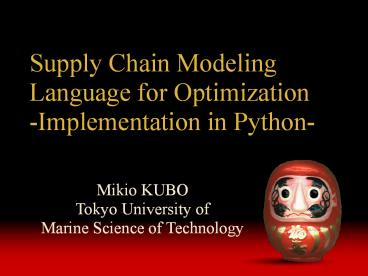Supply Chain Modeling Language for Optimization -Implementation in Python-
Title:
Supply Chain Modeling Language for Optimization -Implementation in Python-
Description:
Supply Chain Modeling Language for Optimization-Implementation in Python-Mikio KUBO Tokyo University of Marine Science of Technology Agenda What s the SCML (Supply ... –
Number of Views:209
Avg rating:3.0/5.0
Title: Supply Chain Modeling Language for Optimization -Implementation in Python-
1
Supply Chain Modeling Language for
Optimization-Implementation in Python-
- Mikio KUBO
- Tokyo University of Marine Science of Technology
2
Agenda
- Whats the SCML (Supply Chain Modeling Language)
- How to implement the SCML in Python
- (Applications)
3
What is the SCML?
proposed in 2009 by M. K. (international
scheduling symposium)
Supply Chain Optimization Models
Solvers (using metaheuristics and/or MIP/CP
solvers)
SCML
SCML.py
Combinatorial Optimization Models
4
Supply chain optimization models
- resource constrained scheduling (RCS)
- lot-sizing (LS)
- logistics network design (LND)
- safety stock allocation (SSA)
- economic order quantity (EOQ)
- inventory policy optimization (IPO)
- vehicle routing (VR)
5
Combinatorial optimization problems
- set covering problem (SC)
- generalized assignment problem (GA)
- rectangular packing problem (RP)
- facility location problem (FL)
- multi-constrained knapsack problem (MK)
- graph coloring problem (GC)
- graph partitioning problem (GP)
- maximum stable set problem (MSS)
- (constrained) bin packing problem (BP)
- quadratic assignment problem (QA)
6
Previous SCO models
Flow models (LND, FL)
Scheduling models (RCS, LS, VR)
Multi-echelon inventory models (IPO, SSA, EOQ, LS)
Constrained optimization models (Algebraic
modeling languages)
7
Previous SCO models
Network(Node, Arc), Product
Activity, Resource
Flow models (LND, FL)
Scheduling models (RCS, LS, VR)
Multi-echelon inventory models (IPO, SSA, EOQ, LS)
Constrained optimization models (Algebraic
modeling languages)
Product (BOM)
Variable, Constraint
8
Activity based view of linear programming
Dantzig-Wolfe (1963)
matrix Aaij
row (constraint) resource
b
-
system input of resource
activity i consumes resource j by aij
column (variable) activity Xj
9
Problem class
Gurobi (MIP) GLPK (MIP/Free) SCOP (CP)
10
Entities of the SCML
- temporal
- piecewise
- horizon
- state
- solver
- etc., ...
- activity
- resource
- product
- node
- arc
Basic entities
11
Activity
- Every action that requires the resources,
consumes and/or produces the product, and derives
the cost
Fixed Cost Variable Cost
consume
produce
activity
product
product
require
resource
12
Resource
- Every entity of limited availability required
and/or consumed by activitiesOur focus is on
the physical, human, and financial resources.
13
Product
- Products are consumed and/or produced by
activities - Products are items or commodities through the
network
consume
produce
activity
product
product
14
Product
- Products are consumed and/or produced by
activities - Products are items or commodities through the
network
arc
node
node
product
product
15
Node and arc
- Network is defined by the set of nodes and arcs
arc
node
node
16
Declaration and attributes
activity declaration activity activity-name
attributes
- activity
- resource
- product
- node
- arc
attribute duedate integer weight
integer consume product-name unit real
... produce product-name unit real ... ...
17
Key concepts for implementing the SCML in Python
- Inheritance / Composition
- Hierarchy
- Global / Local
18
Inheritance
19
Entity class
- Entity has a name and attributes (defined by
arguments as a dictionary)class Entity()
def __init__(self, name"",args) - self.namename
- self.attributescopy.deepcopy(args)
20
An activity object for LS
- act1Activity("act1",variablecost1,
fixedcost53,,leadtime3, resources"res1"1,co
nsume"parts1"1,"parts2"2,produce"prod1"1
) - Class Activity(Entity)
consume
prod1
parts1
activity
produce
parts2
resource
21
Composition
22
Hierarchy
- Hierarchy can be defined on every entity using
attribute children - Every attribute of a parent is copied to its
children (same as inheritance)
activity
children
Mode
Mode
Mode
23
Example an activity object for RP
- item1Activity("item1, cost10,
childrenmode1" resources"width"3,"heig
ht"2 ,mode2 resources"width"2,"heig
ht"3, cost5)
mode2 (cost5)
mode1 (cost10)
24
Global / Local
- Local products can be defined on nodes
- Local activities and resources can be defined on
arcs, i.e., arcs can own activities and resources - Otherwise, entities are called global.
arc
node
node
produce
consume
activity
product
product
require
resource
25
Lot-sizing (LS) model
- horizon, activity, resource, product
consume
product
activity
produce
resource
product
26
Example for solving LS in python (1)
- from SCML import import everything from
SCML module - sampleSCML() generate SCML class
object - sample.setHorizon(5) set the planning horizon
to 5 - generate the product class objects
- prod1Product("prod1",demand5,5,6,7,8,
holdingcost5,leadtime
1) - parts1Product("parts1",holdingcost1,leadtime3)
- parts2Product("parts2",holdingcost1,leadtime1)
- generate the resource class object
- res1Resource(res1,capacity(0,inf)25)
27
Example for solving LS in python (2)
- generate the activity class object
- act1Activity("act1",variablecost1,fixedcost53,
resources"res1"1,consume"parts1"1,"parts2"
2,generate"prod1"1) - add the generated objects into the problem class
- sample.addActivity(act1)
- sample.addProducts(prod1,parts1,parts2)
- sample.addResource(res1)
- sample.solve(LS) solve by the lot-sizing
solver
28
Future plans
- Applications (hybrid models)
- Lot-sizing Inventory policy optimization
- Logistics network design Resource constrained
scheduling Lot-sizing - Excel interface for beginners
- A book on the SCML (will be published in 2010-11
from Asakura Publishers)































